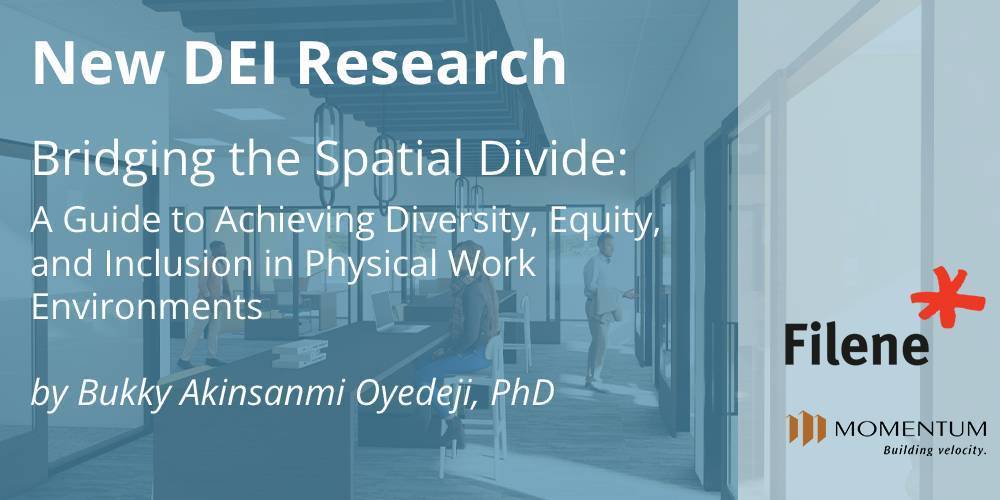Over the past several years, the movement to promote diversity, equity, and inclusion in the workplace and society as a whole has gained significant traction and mainstream acceptance. And the credit union movement has played a significant role in this, with roots in Ed Filene’s important work in social and economic progress.
Today the Filene Research Institute has released a new report, authored by Bukky Akinsanmi Oyedeji, PhD at the McCombs School of Business at UT Austin and sponsored by Momentum, exploring the impacts and opportunities that physical working environments have in regard to diversity, equity, and inclusion.
The report, titled “Bridging the Spatial Divide: A Guide to Achieving Diversity, Equity, and Inclusion in Physical Work Environments,” dives deep into the existing body of research around the impact that physical workplaces have people and proposes a set of guidelines that credit union leaders can follow to help promote diversity and create a sense of belonging in their organizations.
This research has roots in the disability rights movement, where advocates promote an understanding of how design choices impact their ability to interact with and exist within spaces enjoyed comfortably by physically able-bodied people. They changed the way we design buildings with the Americans With Disability Act, but the movement didn’t end there. Through universal design principles, designers bring diverse voices into the process to help create spaces that are truly inclusive for as many people as possible.
In her report, Dr. Oyedeji takes an even wider look at this issue to explore how both surface level dimensions, such as age, sex, gender, race, and ethnicity, as well as less visible dimensions like values, education, experience, and mental abilities, impact how people interact with physical spaces.
Looking at all of these dimensions can reveal how overlooked aspects of a physical workplace can exclude employees or create a sense of otherness.
One interesting example from the report that likely has never occurred to most people is a break room’s ventilation and exhaust system. How could that possible impact diversity or build a sense of inclusion?
Think about what people typically eat for lunch. In traditional white American culture, the most popular staples of a lunch box are cold meals such as sandwiches and salads. But in much of the world, a work lunch consists of flavorful and aromatic hot meals.
A typical break room has the bare minimum ventilation specified for a workplace. This means that if an employee brings in an aromatic comfort food for lunch and microwaves it, it’s likely that the smell of the food will spread quickly throughout the floor and the employee may feel a sense of embarrassment or otherness. Or they’ll conform to the available facilities and bring a sandwich.
Upgrading the break room to better support preparing and eating aromatic food would come at a modest cost during a renovation or new construction, and it would build a sense of inclusivity and tell employees that no matter who they are that they are welcome to be themselves when they sit down for their lunch break.
DEI in the physical workplace is a complex issue. And while the example above may not be relevant to your team or feasible for your workplace, it illustrates how examining the different dimensions of this issue and bringing diverse voices to the table during planning discussions can help you build a better sense of belonging.
Diversity, equity, and inclusion is a vitally important conversation to have today. Empowering people to be their true selves at work has far reaching implications for both them and the organizations that lift them up. People who feel like they belong will feel more engaged and productive, and the diverse ideas that they can bring to a team can help that team be more resilient and better at solving problems.
Learn more by downloading the report on Filene’s website today, and subscribe to our newsletter for more insights on DEI and other issues facing the credit union industry. (The report is unlocked and available to anyone.)
Subscribe to Our Newsletter!
And if you want to learn more about our process and how we can help your credit union build a truly inclusive workplace, reach out today and start the conversation!


